Influence of the Unit Cell Parameters on the Thermomechanical Non-Symmetric In-Plane Shear Behavior of 2D Biaxial Braided Preform for Thermoplastic Biocomposites
Abstract
:1. Introduction
2. Analytical Model Based on Unit Cell Geometry
2.1. Non-Symmetric Unit Cell Geometry of 2D Biaxial Braids
2.2. Analytical Model of Bias-Extension Test for In-Plane Shear Behavior
- –
- Tows are inextensible, or their elongation is null in the bias-extension test;
- –
- There is no slippage between ±β/2 interlacing tows at the cross over points;
- –
- Bending stiffness of tows is neglected.
3. Materials and Experimental Set-Up
3.1. Materials
3.2. Experimental Set-Up
4. Results and Discussion
4.1. Thermo-Condition Dependent Experiments Results
4.2. Influence of Braiding Angle on Thermal In-Plane Shear Behavior
4.3. Asymmetry of the Thermal In-Plane Shear Behavior in AD and TD
4.4. Influence of Tow Waviness and Cover Factor on Thermal In-Plane Shear Behavior
5. Conclusions
Author Contributions
Funding
Data Availability Statement
Acknowledgments
Conflicts of Interest
Appendix A. Thermo-Conditional Verification of Analytical Model
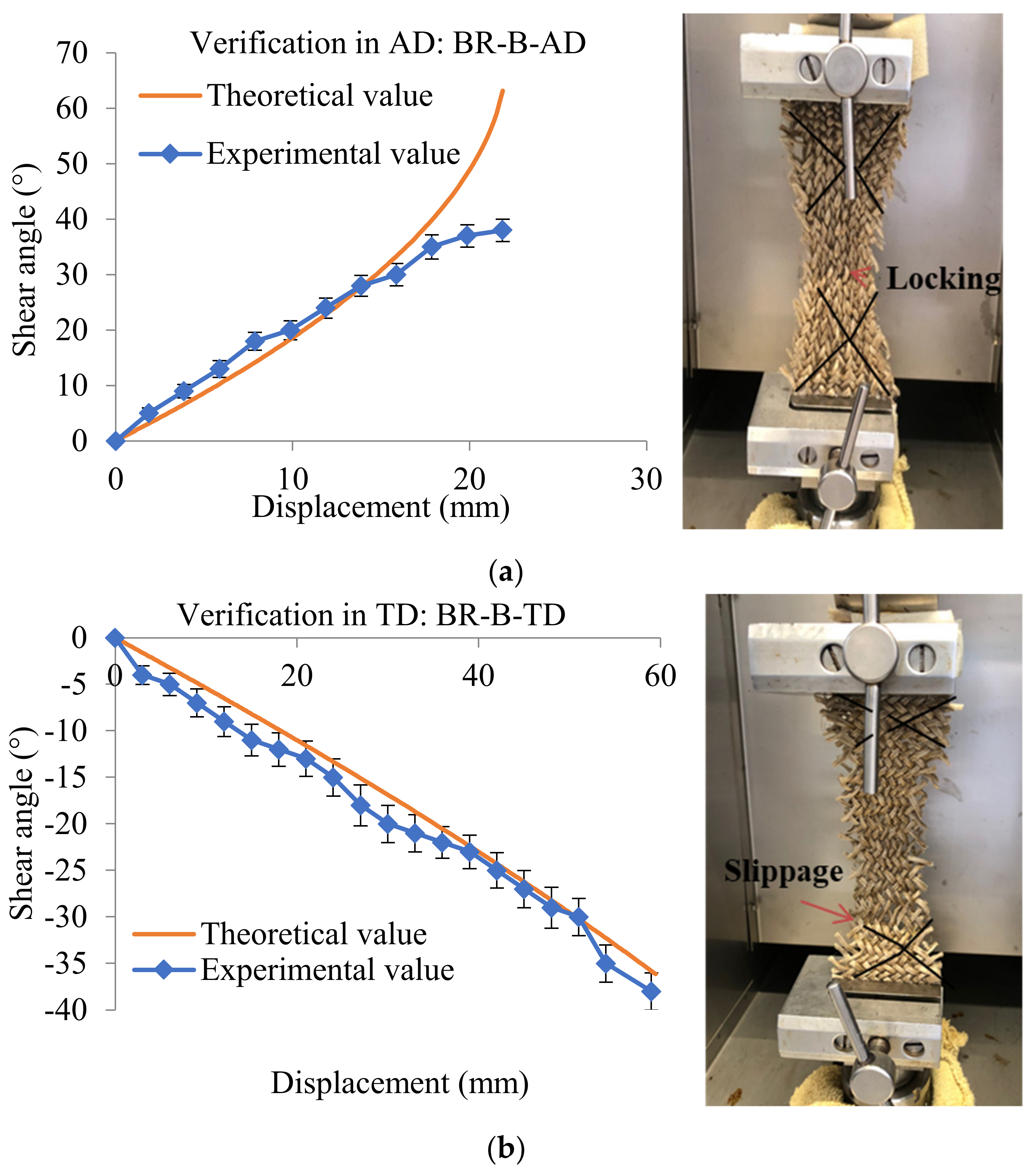
References
- Zade, A.; Kuppusamy, R.R.P. A review on numerical optimization in liquid composite moulding processes. Mater. Today Proc. 2019, 19, 329–332. [Google Scholar] [CrossRef]
- Marichelvam, M.K.; Manimaran, P.; Verma, A.; Sanjay, M.R.; Siengchin, S.; Kandakodeeswaran, K.; Geetha, M. A novel palm sheath and sugarcane bagasse fiber based hybrid composites for automotive applications: An experimental approach. Polym. Compos. 2021, 42, 512–521. [Google Scholar] [CrossRef]
- Bharath, K.N.; Madhu, P.; Gowda, T.G.; Verma, A.; Sanjay, M.R.; Siengchin, S. A novel approach for development of printed circuit board from biofiber based composites. Polym. Compos. 2020, 41, 4550–4558. [Google Scholar] [CrossRef]
- Jain, N.; Verma, A.; Singh, V.K. Dynamic mechanical analysis and creep-recovery behaviour of polyvinyl alcohol based cross-linked biocomposite reinforced with basalt fiber. Mater. Res. Express 2019, 6, 105373. [Google Scholar] [CrossRef]
- Wang, P.; Hamila, N.; Pineau, P.; Boisse, P. Thermomechanical analysis of thermoplastic composite prepregs using bias-extension test. J. Thermoplast. Compos. Mater. 2014, 27, 679–698. [Google Scholar] [CrossRef]
- Gong, Y.; Song, Z.; Ning, H.; Hu, N.; Peng, X.; Wu, X.; Liu, Q. A comprehensive review of characterization and simulation methods for thermo-stamping of 2D woven fabric reinforced thermoplastics. Compos. Part B Eng. 2020, 203, 108462. [Google Scholar] [CrossRef]
- Boisse, P.; Hamila, N.; Guzman-Maldonado, E.; Madeo, A.; Hivet, G.; Dell’Isola, F. The bias-extension test for the analysis of in-plane shear properties of textile composite reinforcements and prepregs: A review. Int. J. Mater. Form. 2017, 10, 473–492. [Google Scholar] [CrossRef]
- Guzman-Maldonado, E.; Hamila, N.; Naouar, N.; Moulin, G.; Boisse, P. Simulation of thermoplastic prepreg thermoforming based on a visco-hyperelastic model and a thermal homogenization. Mater. Des. 2016, 93, 431–442. [Google Scholar] [CrossRef]
- Ouagne, P.; Soulat, D.; Moothoo, J.; Capelle, E.; Gueret, S. Complex shape forming of a flax woven fabric; analysis of the tow buckling and misalignment defect. Compos. Part A Appl. Sci. Manuf. 2013, 51, 1–10. [Google Scholar] [CrossRef]
- Potter, K.; Khan, B.; Wisnom, M.; Bell, T.; Stevens, J. Variability, fibre waviness and misalignment in the determination of the properties of composite materials and structures. Compos. Part A Appl. Sci. Manuf. 2008, 39, 1343–1354. [Google Scholar] [CrossRef]
- Skordos, A.A.; Aceves, C.M.; Sutcliffe, M.P. A simplified rate dependent model of forming and wrinkling of pre-impregnated woven composites. Compos. Part A Appl. Sci. Manuf. 2007, 38, 1318–1330. [Google Scholar] [CrossRef] [Green Version]
- Hallander, P.; Akermo, M.; Mattei, C.; Petersson, M.; Nyman, T. An experimental study of mechanisms behind wrinkle development during forming of composite laminates. Compos. Part A Appl. Sci. Manuf. 2013, 50, 54–64. [Google Scholar] [CrossRef]
- Boisse, P.; Hamila, N.; Vidal-Sallé, E.; Dumont, F. Simulation of wrinkling during textile composite reinforcement forming. Influence of tensile, in-plane shear and bending stiffnesses. Compos. Sci. Technol. 2011, 71, 683–692. [Google Scholar] [CrossRef] [Green Version]
- Lebrun, G.; Bureau, M.N.; Denault, J. Evaluation of bias-extension and picture-frame test methods for the measurement of intraply shear properties of PP/glass commingled fabrics. Compos. Struct. 2003, 61, 341–352. [Google Scholar] [CrossRef]
- Lomov, S.V.; Willems, A.; Verpoest, I.; Zhu, Y.; Barburski, M.; Stoilova, T. Picture frame test of woven composite reinforcements with a full-field strain registration. Text. Res. J. 2006, 76, 243–252. [Google Scholar] [CrossRef]
- Launay, J.; Hivet, G.; Duong, A.V.; Boisse, P. Experimental analysis of the influence of tensions on in plane shear behaviour of woven composite reinforcements. Compos. Sci. Technol. 2008, 68, 506–515. [Google Scholar] [CrossRef] [Green Version]
- Lomov, S.V.; Boisse, P.; Deluycker, E.; Morestin, F.; Vanclooster, K.; Vandepitte, D.; Verpoest, I.; Willems, A. Full-field strain measurements in textile deformability studies. Compos. Part A: Appl. Sci. Manuf. 2008, 39, 1232–1244. [Google Scholar] [CrossRef] [Green Version]
- Cao, J.; Akkerman, R.; Boisse, P.; Chen, J.; Cheng, H.S.; De Graaf, E.F.; Gorczyca, J.L.; Harrison, P.; Hivet, G.; Launay, J.; et al. Characterization of mechanical behavior of woven fabrics: Experimental methods and benchmark results. Compos. Part A Appl. Sci. Manuf. 2008, 39, 1037–1053. [Google Scholar] [CrossRef] [Green Version]
- Corbin, A.C.; Soulat, D.; Ferreira, M.; Labanieh, A.R. Influence of Process Parameters on Properties of Hemp Woven Reinforcements for Composite Applications: Mechanical Properties, Bias-extension Tests and Fabric Forming. J. Nat. Fibers 2022, 19, 714–726. [Google Scholar] [CrossRef]
- Zhu, B.; Yu, T.X.; Tao, X.M. Large shear deformation of E-glass/polypropylene woven fabric composites at elevated temperatures. J. Reinf. Plast. Compos. 2009, 28, 2615–2630. [Google Scholar] [CrossRef]
- Guzman-Maldonado, E.; Hamila, N.; Boisse, P.; Bikard, J. Thermomechanical analysis, modelling and simulation of the forming of pre-impregnated thermoplastics composites. Compos. Part A Appl. Sci. Manuf. 2015, 78, 211–222. [Google Scholar] [CrossRef]
- Machado, M.; Fischlschweiger, M.; Major, Z. A rate-dependent non-orthogonal constitutive model for describing shear behaviour of woven reinforced thermoplastic composites. Compos. Part A Appl. Sci. Manuf. 2016, 80, 194–203. [Google Scholar] [CrossRef]
- Rosa, I.C.; Morgado, T.; Correia, J.R.; Firmo, J.P.; Silvestre, N. Shear behavior of GFRP composite materials at elevated temperature. J. Compos. Constr. 2018, 22, 04018010. [Google Scholar] [CrossRef]
- Pourtier, J.; Duchamp, B.; Kowalsky, M.; Wang, P.; Legrand, X.; Soulat, D. Two-way approach for deformation analysis of non-crimp fabrics in uniaxial bias extension tests based on pure and simple shear assumption. Int. J. Mater. Form. 2019, 12, 995–1008. [Google Scholar] [CrossRef]
- Bel, S.; Boisse, P.; Dumont, F. Analyses of the deformation mechanisms of non-crimp fabric composite reinforcements during preforming. Appl. Compos. Mater. 2012, 19, 513–528. [Google Scholar] [CrossRef]
- Schirmaier, F.J.; Weidenmann, K.A.; Kärger, L.; Henning, F. Characterisation of the draping behaviour of unidirectional non-crimp fabrics (UD-NCF). Compos. Part A Appl. Sci. Manuf. 2016, 80, 28–38. [Google Scholar] [CrossRef]
- De Luycker, E.; Morestin, F.; Boisse, P.; Marsal, D. Simulation of 3D interlock composite preforming. Compos. Struct. 2009, 88, 615–623. [Google Scholar] [CrossRef] [Green Version]
- Dufour, C.; Wang, P.; Boussu, F.; Soulat, D. Experimental investigation about stamping behaviour of 3D warp interlock composite preforms. Appl. Compos. Mater. 2014, 21, 725–738. [Google Scholar] [CrossRef]
- Mathieu, S.; Hamila, N.; Bouillon, F.; Boisse, P. Enhanced modeling of 3D composite preform deformations taking into account local fiber bending stiffness. Compos. Sci. Technol. 2015, 117, 322–333. [Google Scholar] [CrossRef]
- Shen, H.; Wang, P.; Legrand, X. In-plane shear characteristics during the forming of tufted carbon woven fabrics. Compos. Part A Appl. Sci. Manuf. 2021, 141, 160196. [Google Scholar] [CrossRef]
- Duchamp, B.; Legrand, X.; Soulat, D. The tensile behaviour of biaxial and triaxial braided fabrics. J. Ind. Text. 2018, 47, 2184–2204. [Google Scholar]
- Wang, J.; Page, J.R.; Paton, R. Experimental investigation of the draping properties of reinforcement fabrics. Compos. Sci. Technol. 1998, 58, 229–237. [Google Scholar] [CrossRef]
- Potter, K.D. The influence of accurate stretch data for reinforcements on the production of complex structural mouldings: Part 1. Deformation of aligned sheets and fabrics. Composites 1979, 10, 161–167. [Google Scholar] [CrossRef]
- Potter, K. Bias extension measurements on cross-plied unidirectional prepreg. Compos. Part A Appl. Sci. Manuf. 2002, 33, 63–73. [Google Scholar] [CrossRef]
- Nguyen, M.; Herzberg, I.; Paton, R. The shear properties of carbon fabric. Compos. Struct. 1999, 47, 767–779. [Google Scholar] [CrossRef]
- Sharma, S.B.; Sutcliffe, M.P.F.; Chang, S.H. Characterisation of material properties for draping of dry woven composite material. Compos. Part A: Appl. Sci. Manuf. 2003, 34, 1167–1175. [Google Scholar] [CrossRef]
- Xiao, S.; Wang, P.; Soulat, D.; Minet, J.; Zemni, L.; Gao, H. Analysis of the in-plane shear behaviour of non-orthogonally textile reinforcements: Application to braided fabrics. Compos. Part B Eng. 2018, 153, 159–166. [Google Scholar] [CrossRef]
- Potluri, P.; Rawal, A.; Rivaldi, M.; Porat, I. Geometrical modelling and control of a triaxial braiding machine for producing 3D preforms. Composites Part A: Appl. Sci. Manuf. 2003, 34, 481–492. [Google Scholar] [CrossRef]
- Jacquot, P.B.; Wang, P.; Soulat, D.; Legrand, X. Analysis of the preforming behaviour of the braided and woven flax/polyamide fabrics. J. Ind. Text. 2016, 46, 698–718. [Google Scholar] [CrossRef]
- Potluri, P.; Manan, A. Mechanics of non-orthogonally interlaced textile composites. Compos. Part A Appl. Sci. Manuf. 2007, 38, 1216–1226. [Google Scholar] [CrossRef]
- Potluri, P.; Ciurezu, D.P.; Ramgulam, R.B. Measurement of meso-scale shear deformations for modelling textile composites. Compos. Part A Appl. Sci. Manuf. 2006, 37, 303–314. [Google Scholar] [CrossRef]
- Heieck, F.; Hermann, F.; Middendorf, P.; Schladitz, K. Influence of the cover factor of 2D biaxial and triaxial braided carbon composites on their in-plane mechanical properties. Compos. Struct. 2017, 163, 114–122. [Google Scholar] [CrossRef]
- Wang, P.; Hamila, N.; Boisse, P. Thermoforming simulation of multilayer composites with continuous fibres and thermoplastic matrix. Compos. Part B Eng. 2013, 52, 127–136. [Google Scholar] [CrossRef]
- Machado, M.; Murenu, L.; Fischlschweiger, M.; Major, Z. Analysis of the thermomechanical shear behaviour of woven-reinforced thermoplastic-matrix composites during forming. Compos. Part A Appl. Sci. Manuf. 2016, 86, 39–48. [Google Scholar] [CrossRef]
- Xiao, S.; Wang, P.; Soulat, D.; Legrand, X. Structure and mechanics of braided fabrics. In Structure and Mechanics of Textile Fibre Assemblies; Woodhead Publishing: Sawston, UK, 2019; pp. 217–263. [Google Scholar]
- Potluri Braiding, P. Wiley Encyclopedia of Composites, 2nd ed.; Nicolais, L., Borzacchiello, A., Eds.; John Wiley & Sons, Inc.: Hoboken, NJ, USA, 2012. [Google Scholar]
- Tang, X.; Whitcomb, J.D.; Kelkar, A.D.; Tate, J. Progressive failure analysis of 2 × 2 braided composites exhibiting multiscale heterogeneity. Compos. Sci. Technol. 2006, 66, 2580–2590. [Google Scholar] [CrossRef]
- Härtel, F.; Harrison, P. Evaluation of normalisation methods for uniaxial bias extension tests on engineering fabrics. Compos. Part A Appl. Sci. Manuf. 2014, 67, 61–69. [Google Scholar] [CrossRef] [Green Version]
- Wang, P.; Hamila, N.; Boisse, P.; Chaudet, P.; Lesueur, D. Thermo-mechanical behavior of stretch-broken carbon fiber and thermoplastic resin composites during manufacturing. Polym. Compos. 2015, 36, 694–703. [Google Scholar] [CrossRef]
- Wang, P.; Legrand, X.; Boisse, P.; Hamila, N.; Soulat, D. Experimental and numerical analyses of manufacturing process of a composite square box part: Comparison between textile reinforcement forming and surface 3D weaving. Compos. Part B Eng. 2015, 78, 26–34. [Google Scholar] [CrossRef]
- Zhai, W.; Wang, P.; Legrand, X.; Soulat, D.; Ferreira, M. Effects of Micro-Braiding and Co-Wrapping Techniques on Characteristics of Flax/Polypropylene-Based Hybrid Yarn: A Comparative Study. Polymers 2020, 12, 2559. [Google Scholar] [CrossRef]
- Gautam, M.; Sivakumar, S.; Barnett, A.; Barbour, S.; Ogin, S.L.; Potluri, P. On the behaviour of flattened tubular Bi-axial and Tri-axial braided composites in tension. Compos. Struct. 2020, 261, 113325. [Google Scholar] [CrossRef]
- NF EN ISO 5084; Textiles—Determination of Thickness of Textiles and Textile Products; AFNOR: La Plaine Saint-Denis, France, 1996.
- NF EN ISO 12127; Textiles—Fabrics—Determination of Mass per Unit Area Using Small Samples; AFNOR: La Plaine Saint-Denis, France, 1998.
- NF EN ISO 9237; Textiles—Determination of Permeability of Fabrics to Air; AFNOR: La Plaine Saint-Denis, France, 1995.
- Xiao, S.; Wang, P.; Soulat, D.; Gao, H. Thermo-Mechanical Characterisations of Flax Fibre and Thermoplastic Resin Composites during Manufacturing. Polymers 2018, 10, 1139. [Google Scholar] [CrossRef] [PubMed] [Green Version]
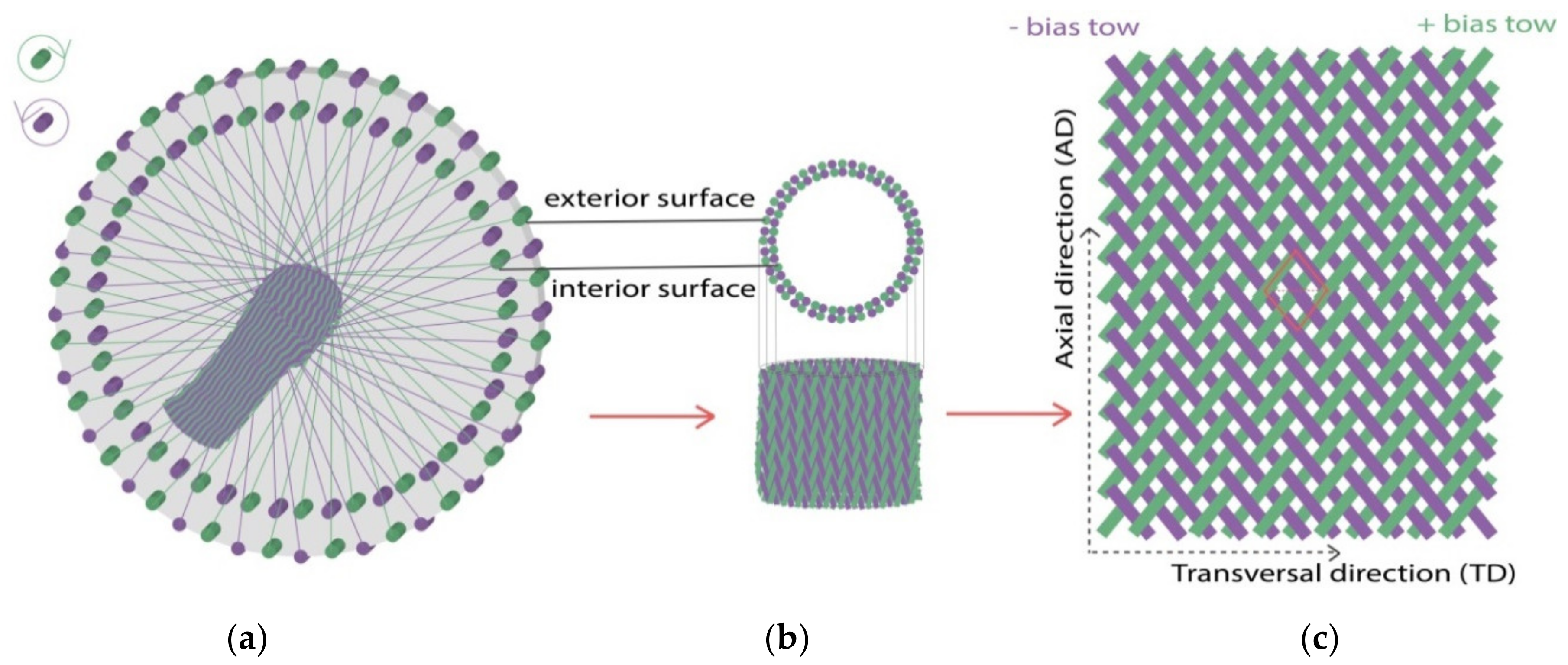
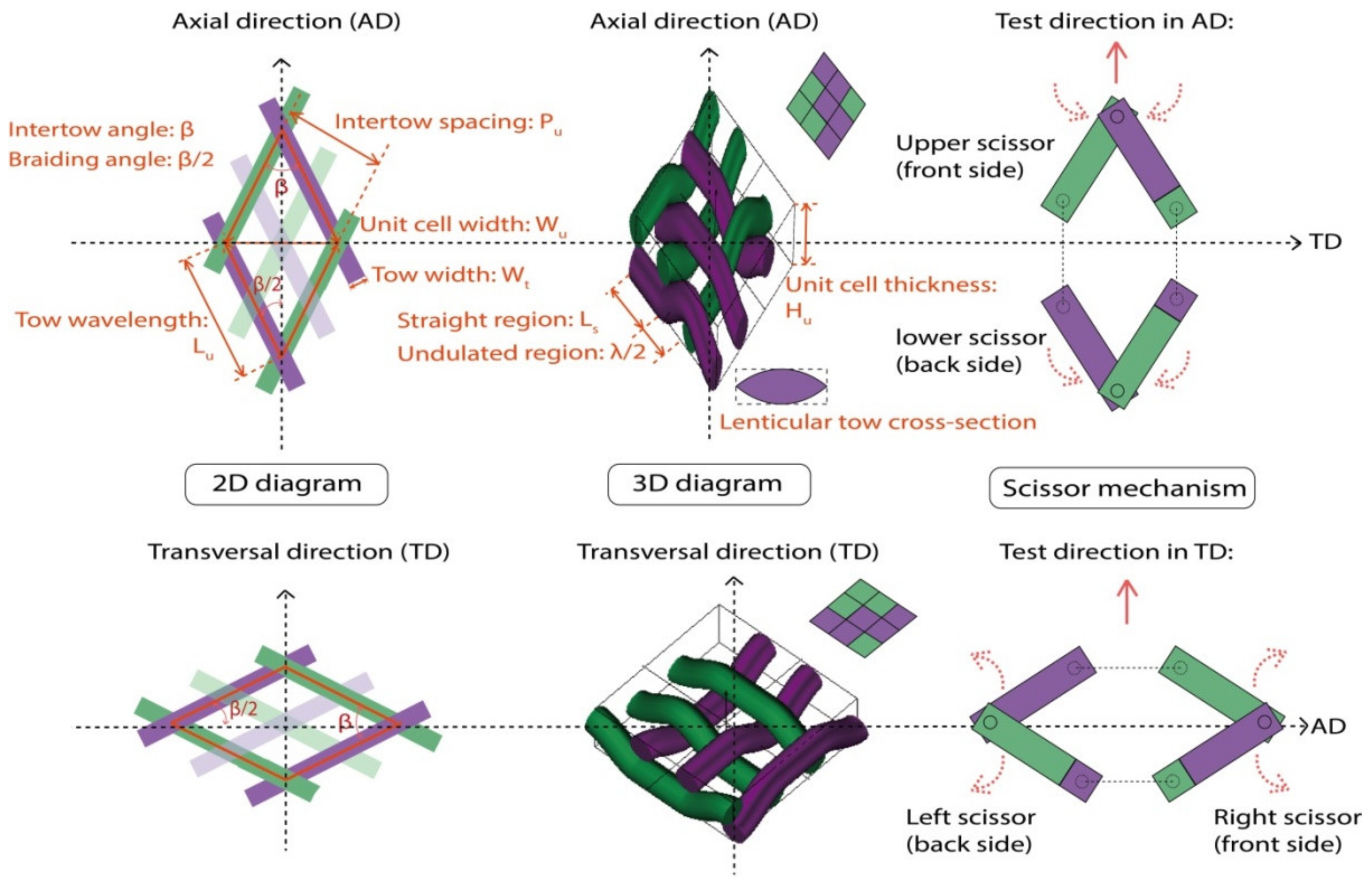

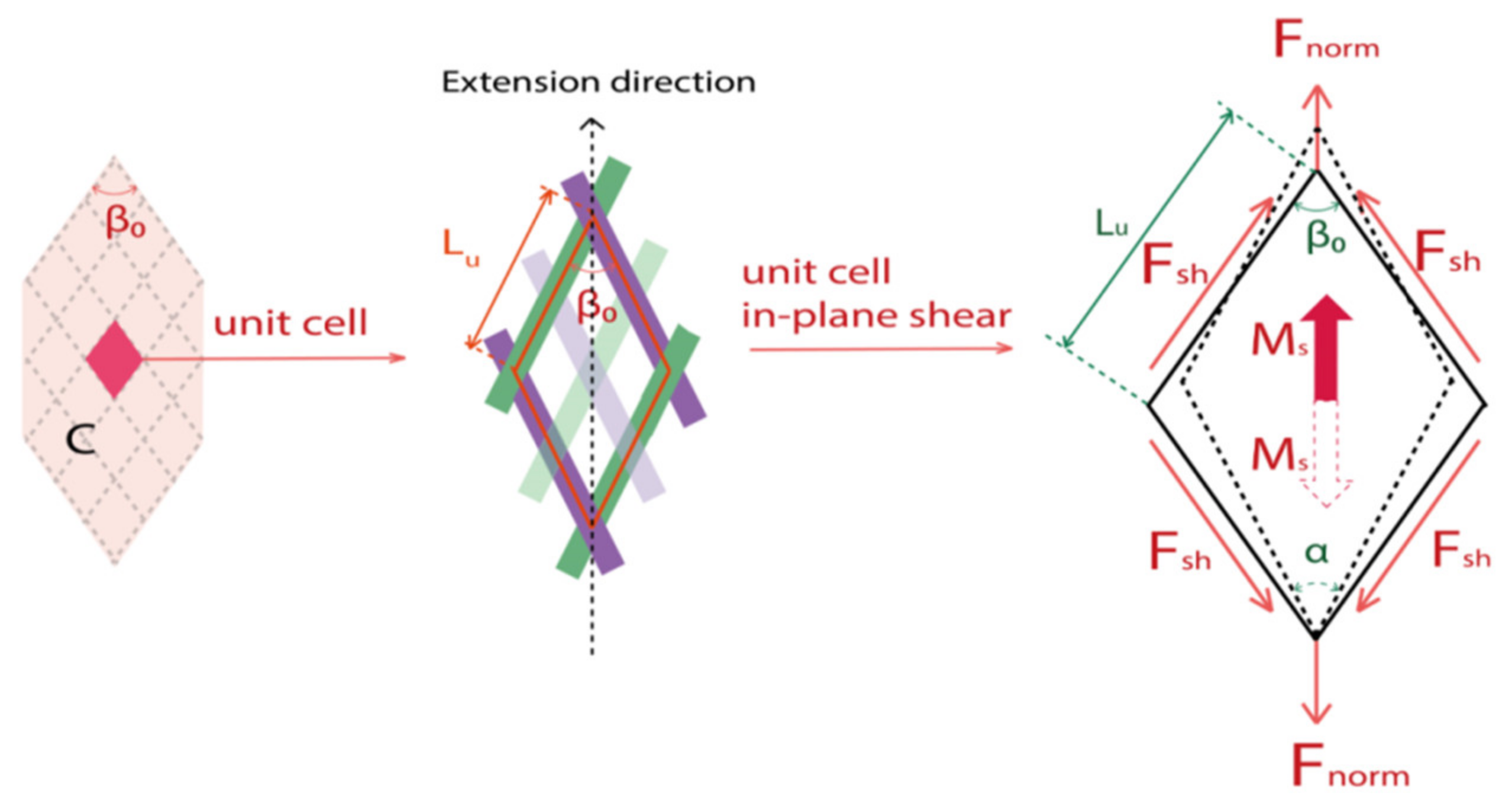
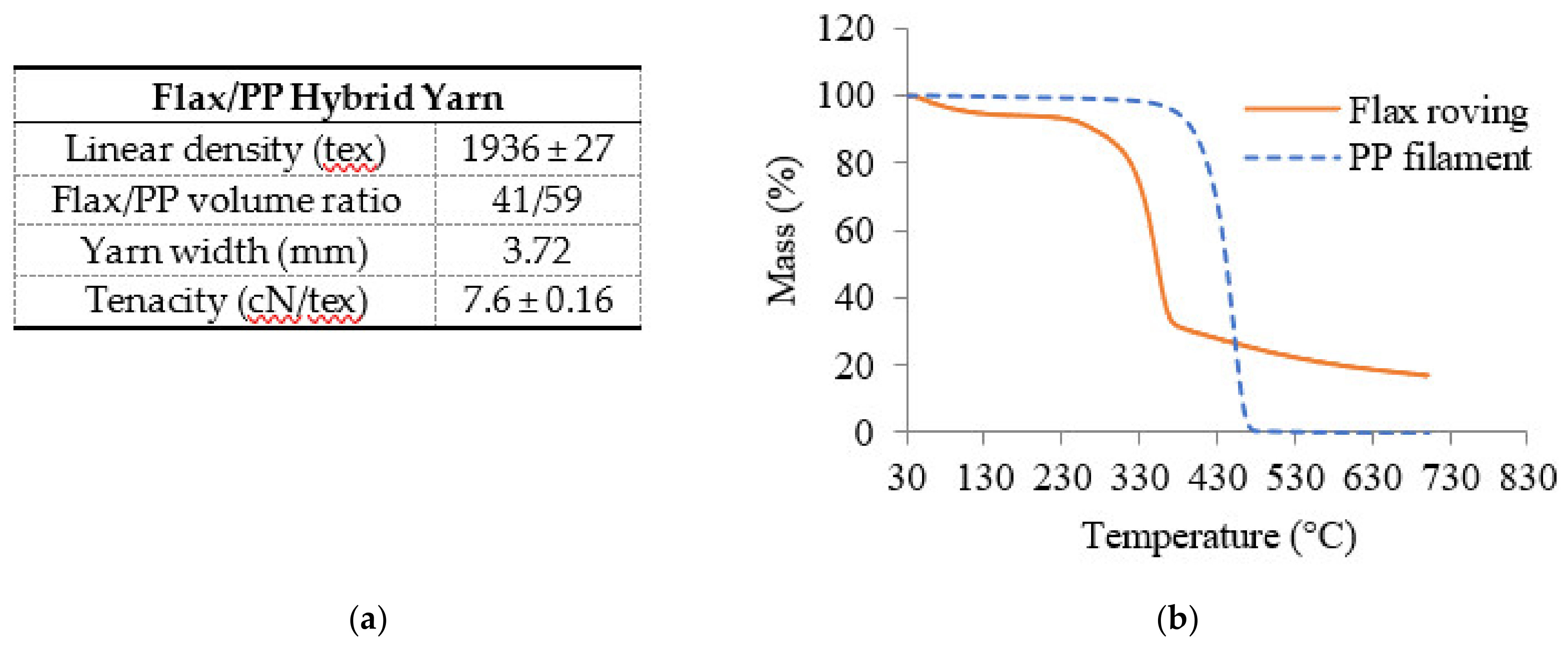

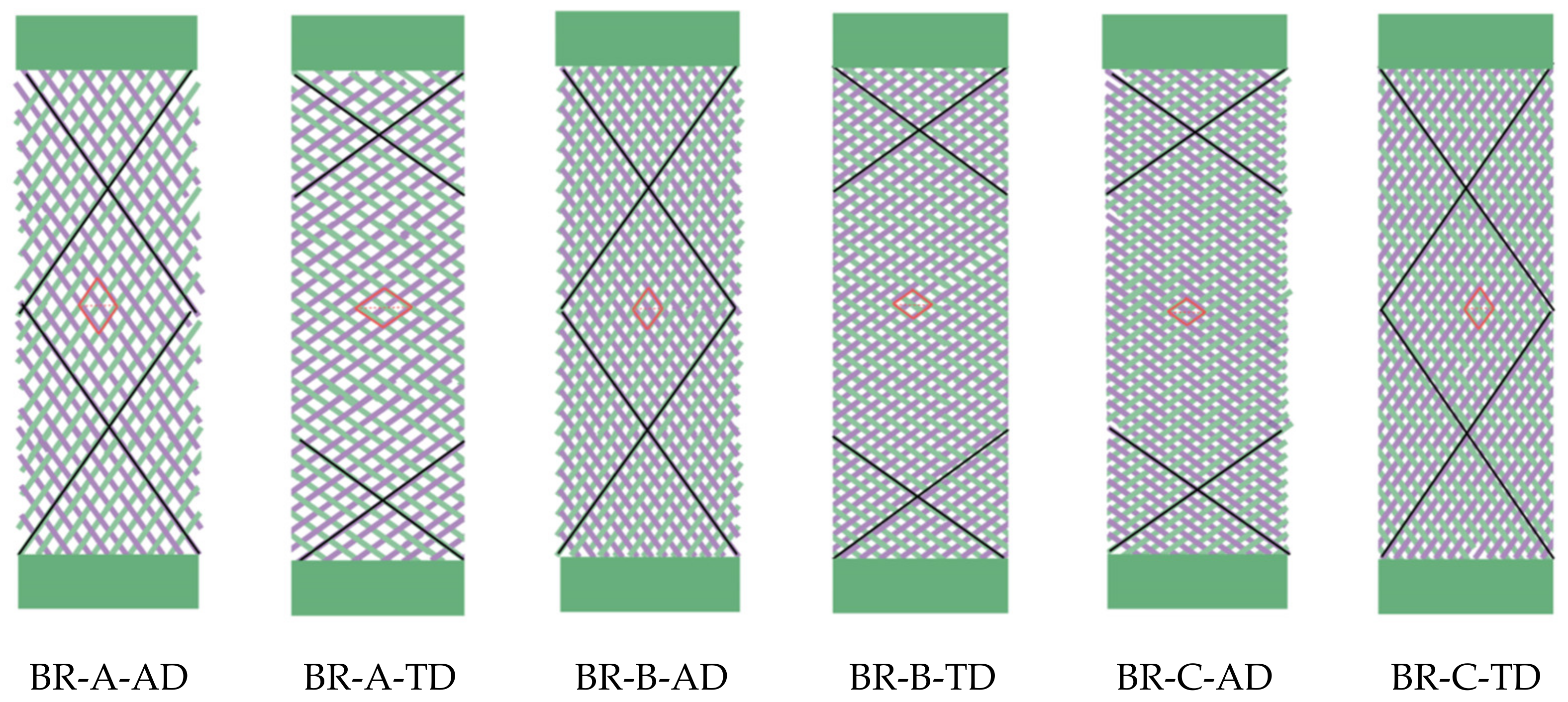
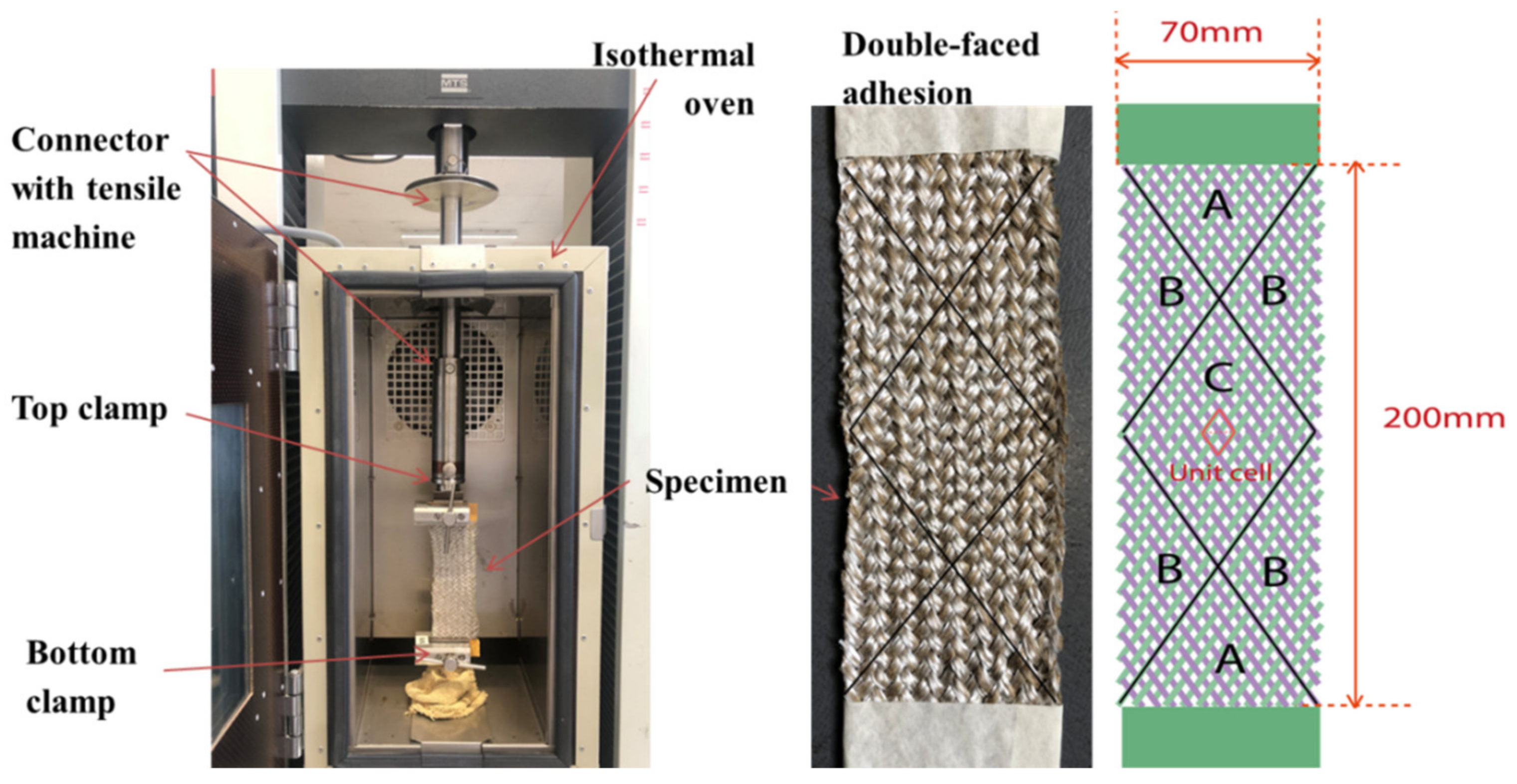
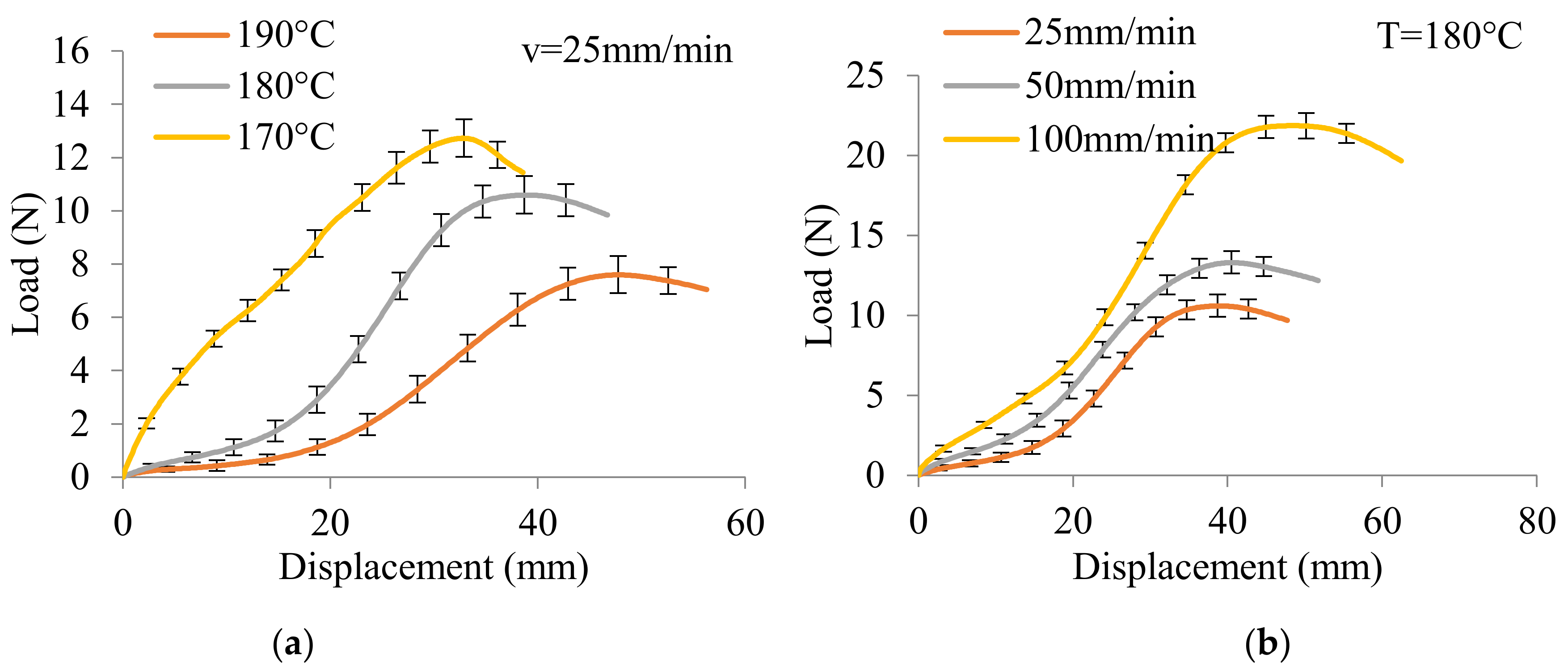

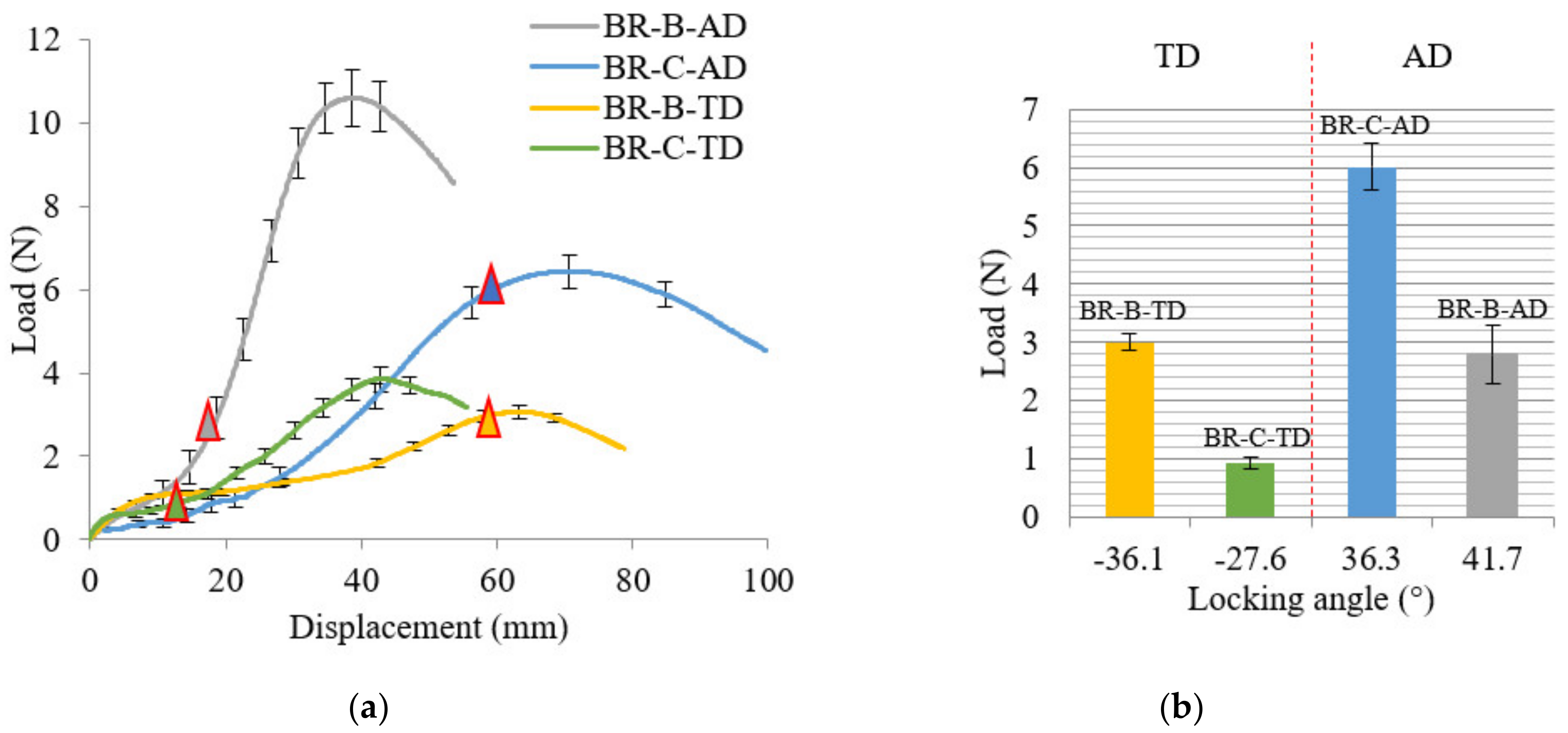
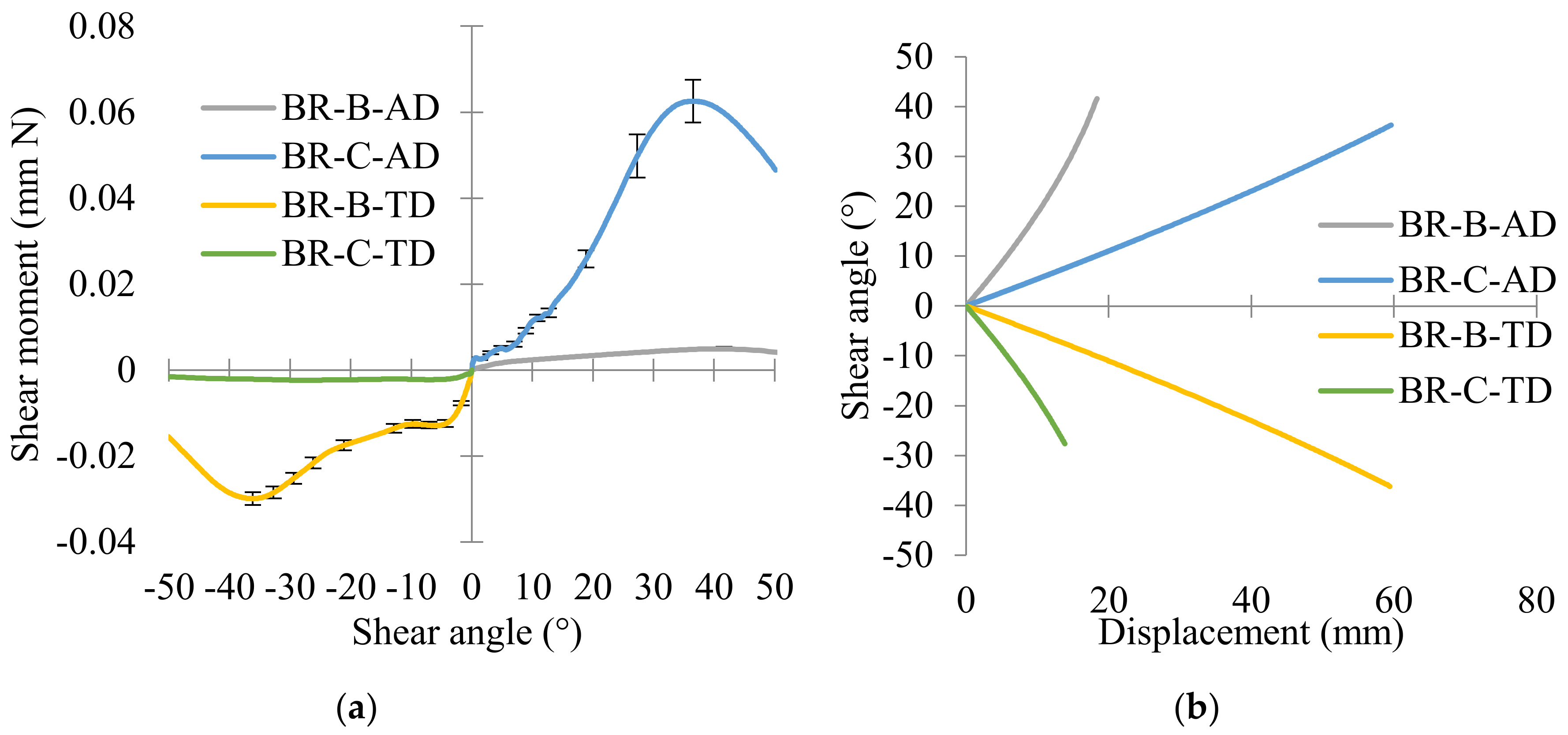
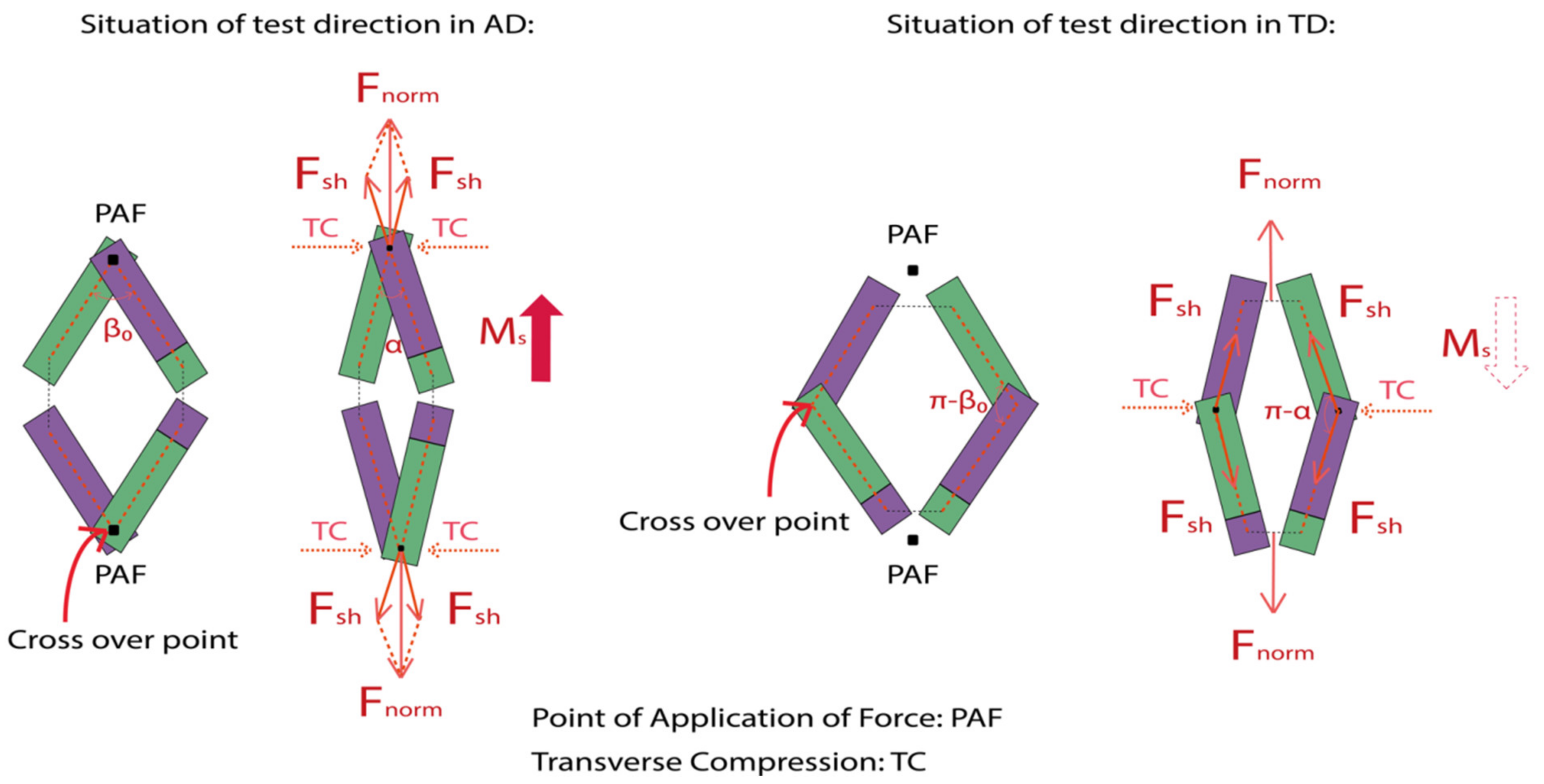
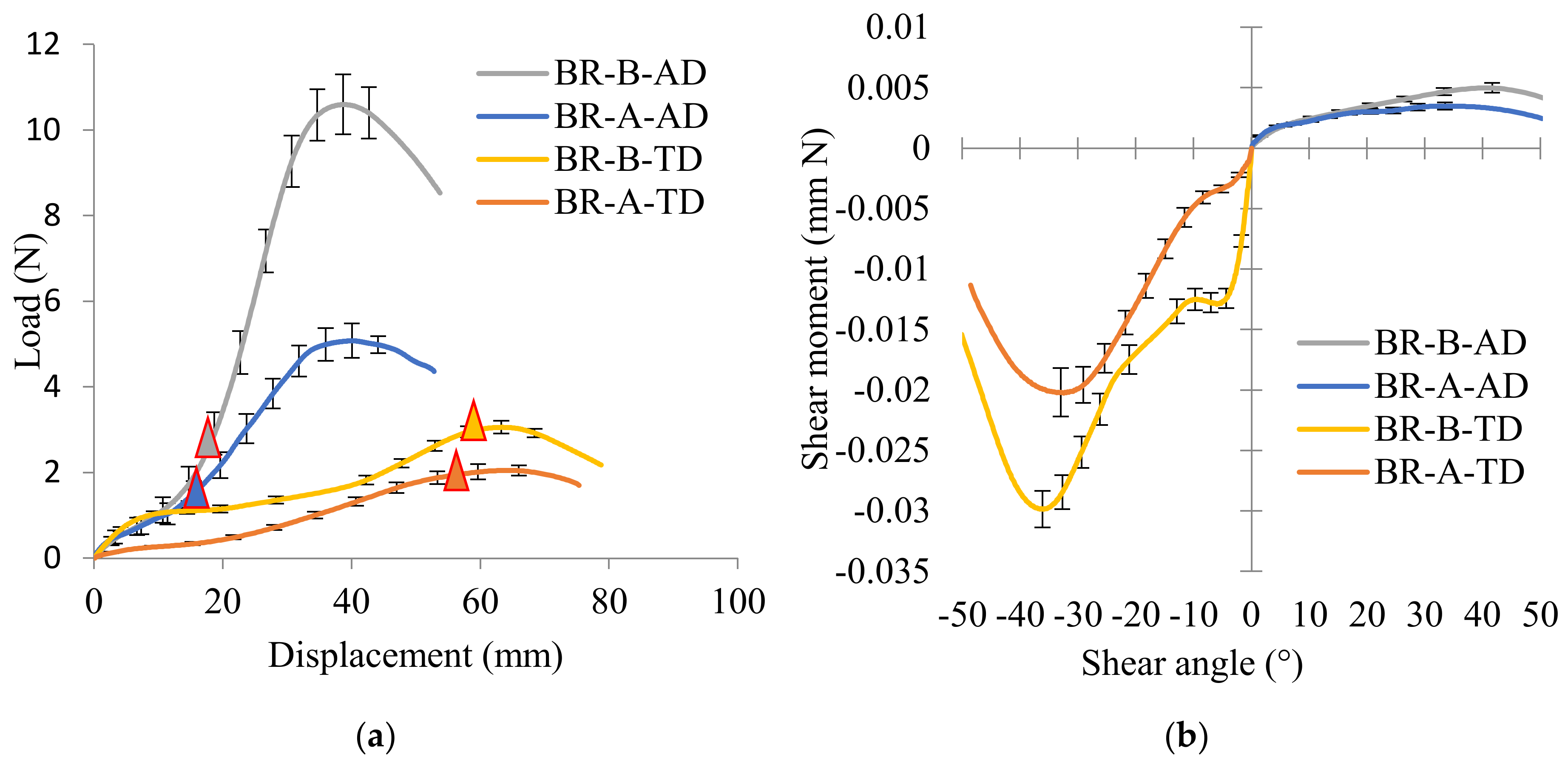

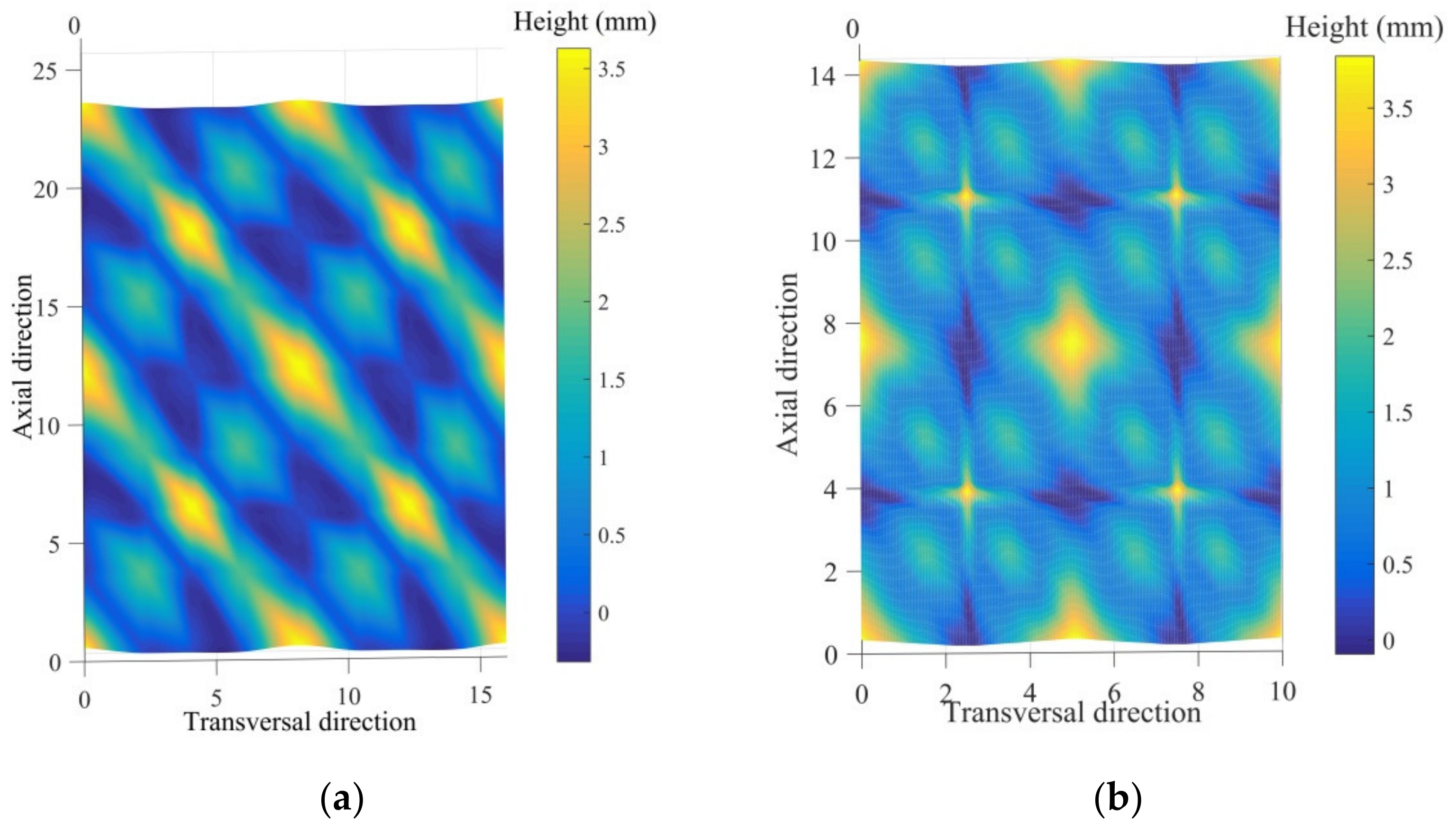
| BR-A-AD | BR-A-TD | BR-B-AD | BR-B-TD | BR-C-AD | BR-C-TD | |
| Braiding angle (°) | 35 | 35 | 35 | 35 | 55 | 55 |
| Intertow angle in the test direction (°) | 70 | 110 | 70 | 110 | 110 | 70 |
| Unit cell width (mm) | 16.4 | 23.4 | 11.5 | 16.4 | 16.4 | 11.5 |
| Tow waviness ratio | 0.31 | 0.31 | 0.46 | 0.46 | 0.46 | 0.46 |
| Cover factor (%) | 80.1 | 80.1 | 95.7 | 95.7 | 95.7 | 95.7 |
| Thickness (mm) | 3.62 ± 0.03 | 3.62 ± 0.03 | 3.82 ± 0.07 | 3.82 ± 0.07 | 3.81 ± 0.09 | 3.81 ± 0.09 |
| Areal density (g/m2) | 928 ± 30 | 928 ± 30 | 1078 ± 10 | 1078 ± 10 | 1070 ± 18 | 1070 ± 18 |
| Air permeability (l/m2/s) | 859 ± 46 | 859 ± 46 | 460 ± 26 | 460 ± 26 | 471 ± 26 | 471 ± 26 |
| T (°C) | V (mm/min) | |
|---|---|---|
| Variant of T with fixed V | 170 | 25 |
| 180 | ||
| 190 | ||
| Variant of V with fixed T | 180 | 25 |
| 50 | ||
| 100 |
| Max Extension Load (N) | Displacement at Max Load (mm) | Locking Angle (°) | Displacement at Locking Angle (mm) | Load at Locking Angle (N) | Max Shear Moment (mm N) | |
|---|---|---|---|---|---|---|
| BR-A-AD | 5.08 ± 0.4 | 40.06 ± 2.54 | 33 | 15.77 | 1.56 | 0.0035 |
| BR-A-TD | 2.02 ± 0.18 | 59.66 ± 3.12 | −32.5 | 54.33 | 1.91 | −0.02 |
| BR-B-AD | 10.6 ± 0.7 | 38.7 ± 2.09 | 41.7 | 18.37 | 2.79 | 0.0046 |
| BR-B-TD | 3.06 ± 0.15 | 63.28 ± 4.17 | −36.1 | 59.45 | 3.00 | -0.03 |
| BR-C-AD | 6.43 ± 0.4 | 70.62 ± 4.58 | 36.3 | 59.62 | 6.01 | 0.061 |
| BR-C-TD | 3.86 ± 0.3 | 42.98 ± 2.51 | −27.6 | 13.81 | 0.92 | −0.0023 |
Publisher’s Note: MDPI stays neutral with regard to jurisdictional claims in published maps and institutional affiliations. |
© 2022 by the authors. Licensee MDPI, Basel, Switzerland. This article is an open access article distributed under the terms and conditions of the Creative Commons Attribution (CC BY) license (https://creativecommons.org/licenses/by/4.0/).
Share and Cite
Zhai, W.; Soulat, D.; Legrand, X.; Wang, P. Influence of the Unit Cell Parameters on the Thermomechanical Non-Symmetric In-Plane Shear Behavior of 2D Biaxial Braided Preform for Thermoplastic Biocomposites. Polymers 2022, 14, 1117. https://doi.org/10.3390/polym14061117
Zhai W, Soulat D, Legrand X, Wang P. Influence of the Unit Cell Parameters on the Thermomechanical Non-Symmetric In-Plane Shear Behavior of 2D Biaxial Braided Preform for Thermoplastic Biocomposites. Polymers. 2022; 14(6):1117. https://doi.org/10.3390/polym14061117
Chicago/Turabian StyleZhai, Wenqian, Damien Soulat, Xavier Legrand, and Peng Wang. 2022. "Influence of the Unit Cell Parameters on the Thermomechanical Non-Symmetric In-Plane Shear Behavior of 2D Biaxial Braided Preform for Thermoplastic Biocomposites" Polymers 14, no. 6: 1117. https://doi.org/10.3390/polym14061117
APA StyleZhai, W., Soulat, D., Legrand, X., & Wang, P. (2022). Influence of the Unit Cell Parameters on the Thermomechanical Non-Symmetric In-Plane Shear Behavior of 2D Biaxial Braided Preform for Thermoplastic Biocomposites. Polymers, 14(6), 1117. https://doi.org/10.3390/polym14061117








